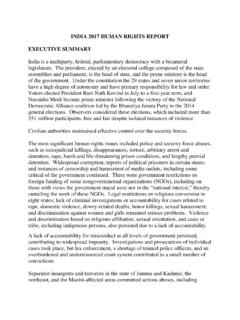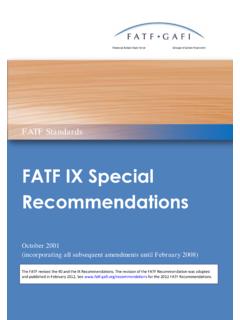Transcription of International Country Risk Guide Methodology
1 Reproduction without written permission of The PRS Group, Inc. is strictly prohibited International Country Risk Guide Methodology The International Country Risk Guide (ICRG) rating comprises 22 variables in three subcategories of risk: political, financial, and economic. A separate index is created for each of the subcategories. The Political Risk index is based on 100 points, Financial Risk on 50 points, and Economic Risk on 50 points. The total points from the three indices are divided by two to produce the weights for inclusion in the composite Country risk score. The composite scores, ranging from zero to 100, are then broken into categories from Very Low Risk (80 to 100 points) to Very High Risk (zero to points).
2 The Political Risk Rating includes 12 weighted variables covering both political and social attributes. ICRG advises users on means of adapting both the data and the weights in order to focus the rating on the needs of the particular investing firm. ICRG incorporates a Type II forecast (see Chapter 1, Introduction, of PRS textbook The Handbook of Country and Political Risk Analysis) in which its experts provide a current assessment, a one-year assessment, and a five-year assessment. The projections of future conditions are framed in best case and worst case scenarios. This provides managers with a probabilistic future in which to make judgments about risk management or insurance needs. Country analyses in ICRG include descriptive assessments and economic data (listed on this site under Historical Analyses ).
3 ICRG provides ratings for 140 countries on a monthly basis, and for an additional 26 countries on an annual basis under a different title. ---Llewellyn D. Howell, BACKGROUND OF THE ICRG RATING SYSTEM The ICRG model for forecasting financial, economic, and political risk was created in 1980 by the editors of International Reports, a widely respected weekly newsletter on International finance and economics. To meet the needs of clients for an in-depth and exhaustively researched analysis of the potential risks to International business operations, the editors created a statistical model to calculate risks and backed it up with analyses that explain the numbers and examine what the numbers do not show. The result is a comprehensive system that enables various types of risk to be measured and compared between countries.
4 In 1992, ICRG, its editor and analysts moved from International Reports to The PRS Group, becoming an integral part of the company s services to the International business community. In September 2001, PRS launched ICRG online. One advantage of the ICRG model is that it allows users to make their own risk assessments based on the ICRG model or to modify the model to meet their specific requirements. If particular risk factors have greater bearing on business or investments, composite risk ratings can be recalculated by giving greater weight to those factors. Used by institutional investors, banks, multinational corporations, importers, exporters, foreign exchange traders, shipping concerns, and a multitude of others, the ICRG model can determine how financial, economic, and political risk might affect their business and investments now and in the future.
5 Reproduction without written permission of The PRS Group, Inc. is strictly prohibited The system is based on a set of 22 components grouped into three major categories of risk: political, financial, and economic, with political risk comprising 12 components (and 15 subcomponents), and financial and economic risk each comprising five components. Each component is assigned a maximum numerical value (risk points), with the highest number of points indicating the lowest potential risk for that component and the lowest number (0) indicating the highest potential risk. The maximum points able to be awarded to any particular risk component is pre-set within the system and depends on the importance (weighting) of that component to the overall risk of a Country .
6 The ICRG staff collects political information and financial and economic data, converting these into risk points for each individual risk component on the basis of a consistent pattern of evaluation. The political risk assessments are made on the basis of subjective analysis of the available information, while the financial and economic risk assessments are made solely on the basis of objective data. In addition to the 22 individual ratings, the ICRG model also produces a rating for each of the three risk factor groups plus an overall score for each Country . After a risk assessment (rating) has been awarded to each of the 22 risk components, the components within each category of risk are added together to provide a risk rating for each risk category (Political, Financial, or Economic).
7 The risk ratings for these categories are then combined on the basis of a formula to provide the Country s overall, or composite, risk rating. As with the risk component ratings, the higher the rating computed for the political, financial, economic, or composite rating, the lower the risk, and vice versa. Consequently, the ICRG system presents a comprehensive risk structure for the Country with ratings for its overall, or composite, risk, for its political, financial, and economic risk and for the risk components that make up these broad risk categories. This approach enables the user to track the effect of a single risk component, or group of components, on the overall risk of a Country . In addition, ICRG also produces the information and data on which the ratings for the individual risk components are determined, together with its interpretation of that information or data.
8 This enables the user of the system to balance his/her own interpretation of the information and data against that of the ICRG staff. THE POLITICAL RISK RATING The aim of the political risk rating is to provide a means of assessing the political stability of the countries covered by ICRG on a comparable basis. This is done by assigning risk points to a pre-set group of factors, termed political risk components. The minimum number of points that can be assigned to each component is zero, while the maximum number of points depends on the fixed weight that component is given in the overall political risk assessment. In every case the lower the risk point total, the higher the risk, and the higher the risk point total the lower the risk. To ensure consistency, both between countries and over time, points are assigned by ICRG editors on the basis of a series of pre-set questions for each risk component.
9 Reproduction without written permission of The PRS Group, Inc. is strictly prohibited THE POLITICAL RISK COMPONENTS Table 3B The following risk components, weights, and sequence are used to produce the political risk rating: POLITICAL RISK COMPONENTS Sequence Component Points (max.) * A Government Stability 12* B Socioeconomic Conditions 12* C Investment Profile 12* D Internal Conflict 12* E External Conflict 12 F Corruption 6 G Military in Politics 6 H Religious Tensions 6 I Law and Order 6 J Ethnic Tensions 6 K Democratic Accountability 6 L Bureaucracy Quality 4 Total 100 * Risk rating subcomponent data available only starting as of May 2001 Government Stability 12 Points This is an assessment both of the government s ability to carry out its declared program(s), and its ability to stay in office.
10 The risk rating assigned is the sum of three subcomponents, each with a maximum score of four points and a minimum score of 0 points. A score of 4 points equates to Very Low Risk and a score of 0 points to Very High Risk. The subcomponents* are: Government Unity Legislative Strength Popular Support Socioeconomic conditions 12 Points This is an assessment of the socioeconomic pressures at work in society that could constrain government action or fuel social dissatisfaction. The risk rating assigned is the sum of three subcomponents, each with a maximum score of four points and a minimum score of 0 points. A score of 4 points equates to Very Low Risk and a score of 0 points to Very High Risk. The subcomponents* are: Unemployment Consumer Confidence Poverty Investment Profile 12 Points This is an assessment of factors affecting the risk to investment that are not covered by other political, economic and financial risk components.



